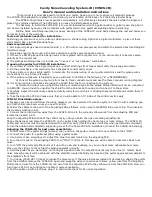
Installation, Operation and Service Manual
LKP Series
© 2016 DynAmp, LLC
Page 25
041738 I
Beginning at a magnetic sensor in the Measuring Head, we can trace the signal path. To
achieve a signal output in the presence of a magnetic field, the sensor (Hall plate) must be
supplied a small exciting current. This current is called the control current (I
c
), and it is
approximately 6 mAdc for each sensor. The control current is derived from the 12 Vdc
power supply in the Metering Unit. Since the sensor resistance is low (about 200 ohm),
the sensor current is limited by two 1500-ohm resistors (one on each side of the sensor).
These resistors are located in the Measuring Head.
With a constant dc control current applied to a sensor in the presence of a dc magnetic
field, the sensor output is a dc voltage proportional to the dc field. The sensor output
voltage is conducted via the interconnecting cable to the Metering Unit, where it becomes
the signal input.
6.5 METERING UNIT
Although each modular unit contains only two circuit boards, it is comprised of several sub-
circuits. Each of these circuits is described in the remaining paragraphs.
6.6 POWER SUPPLIES
The LKP module contains a ±15 Vdc power supply, which powers only the on-board
circuitry. The first module in the Metering Unit (also referred to as Module “A”) contains a
12 Vdc power supply for the Hall devices.
6.7 SYNC, PLL, AND RAMPS
The Metering Unit employs phase locked loop circuitry for synchronization of the firing
pulses of the SCRs. This particularly is an advantage when there is a high noise level
present on the line voltage. The PLL circuitry consists of U101, U102, and associated
circuitry. The line voltage is sensed at TP-4. It is then filtered and sent to U112 to be
converted into a square wave, and then to the PLL circuitry. The output of the PLL is a
square wave and is present at TP-2. This signal is sent to U104, U105, and RP101, which
constitutes the ramp generator. The ramp generator output consists of two downward
sloping ramps, each 180 degrees out of phase from one another. Both ramps are sent to
the quad comparators (U110 and U111), which are used to generate the firing pulses for
the SCRs.
6.8 ERROR AMPLIFIERS
The error amplifier circuitry consists of U106 through U109 and associated circuitry. The
error amplifiers serve two purposes, to amplify the Hall error signal and to filter it before
sending it to the comparators.
6.9 COMPARATORS AND PULSE GENERATOR
The comparators consist of U110 and U111. They compare the amplified and filtered
output of the error amplifiers to the two ramps generated by PLL and ramp generators.











































